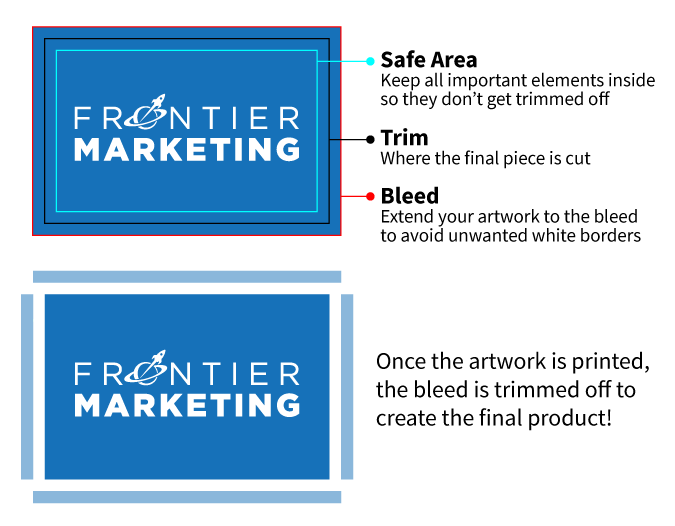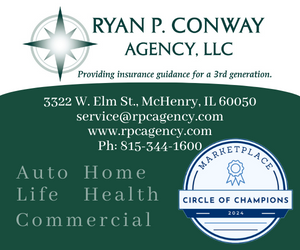Nikki O’Donnell
Nikki is the COO of Frontier Marketing
Here’s Everything You Should Know About Producing Print Marketing Materials for Your Business!
Print, contrary to popular belief, is not dead. And it’s especially not dead for small businesses who use print marketing the right way. Your print marketing material is a tangible object that customers can hold onto. Eye-catching designs have the power to encourage potential customers to visit your store.
Posters, flyers, general advertisements, and business cards are all types of marketing materials. Anything that increases your brand awareness in physical form is print marketing.
The power of print lives and dies with how well the material is produced. Using a professional printer and designer increases your chances that your brand will not only be seen, it will be remembered.
If you are looking at creating your own print marketing materials, here are a few things you need to know!
1. Use High-Resolution Images
Have you ever had a print job done, and the image turns out grainy or blurred? That’s because you were using a low-resolution image for a high-resolution job. Using high-quality images means you don’t have to worry as much about re-sizing issues.
Print and digital also use different metrics for images. When an image is printed, it is done through dots. Dots create the images you see. Online, they are created with pixels. If you use digital images for a print job, make sure it is at least 300 PPI (pixels per inch).
300 PPI is the standard for printing. If the project is larger, like a poster or banner, it will need to be bigger. Find out from a professional printer what the dimensions should be.
Figuring out the size of your print image is simple. Multiply 300 by the dimensions of your print marketing material. For example, a 4×6 print will need to be 1200×1800 pixels.

2. Extend Your Artwork to the Bleed
Bleed is a term for when printing goes beyond the edge of where the document will be trimmed. That means it goes off the allotted space, and it needs to be cut off. The bleed is also the part that gives the printer space to account for movement of the paper and design inconsistencies.
When a professional printer prints your document, they will trim the edges off so that your design is crisp. Being able to account for errors in the document allows the printer to avoid white spaces and other blemishes.
If you go with a professional printer, make sure you know what the specs for printing are. The printer will give a “safe area” that you can design in. Following these specs can save you money as well. You won’t have to re-print or re-design if the product comes out the wrong way.
3. Embed Your Unique Fonts
Many businesses have created fonts specific to their brands. Some also purchased a fonts already created for their brands.
For example, Apple uses a custom font called San Francisco. It was created specifically for Apple to use. So, it’s not on any standard computer or printer.
So, if Apple were a small business looking to keep their brand intact when their documents are printed, they would embed the font.
Embedding the fonts means saving the font as is. When your document is opened on another computer or sent through a printer, the software will read it as an image rather than a font. This stops the computer or printer from automatically converting it to a more standardized font, such as Calibri or Arial.
Because Nike’s font comes with Microsoft products, chances are they wouldn’t have to embed it. So, if you use a professional printing service, then you should find out if they have your font before going to the trouble of embedding your font.
The easiest way to embed your font is to convert the entire document into a PDF. If you’re designing on Word, simply go to File > Export > Create PDF/XPS Document. That’s the document you will send to your printer.
Embedding fonts will also increase the size of your file, so use it sparingly and only when you think it has the greatest impact. Exporting your work as a PDF file is an easy way to embed the fonts for future use.
4. Check Your Color Modes
When it comes to business marketing materials, you have two options: print or digital. Likewise, when designing, there are two color modes that suit each need: CMYK and RGB. The color mode depends on which medium you’re using.
CMYK should be used for print, and RGB should be used for digital. If you mix the two modes up, it could cause the colors to look “off.” As you’re learning how to make a print ad, color choice becomes important. You don’t want the colors to look different than you intended.
For example, a blue color might not be the same shade as on your computer. How “off” the colors look varies by design and coloring arrangement. Your customers will be able to tell something is not quite right with your materials, and it will be off-putting to them.
Professional printers will take your design and automatically change the color mode, which is another reason to go with them instead of doing it on your own.

5. Fix Your File Formats
The file format that you send to the printer will affect how it looks when it is produced. When it comes to how your print marketing materials are saved, there are several things to know.
Raster vs. Vector File
Every photo you see online is a raster image. That means in order to retain pixel quality, you cannot resize without compromising the resolution. Raster images are made up by pixels. Enlarging them will only increase the size of the pixels and cause a loss of quality.
On the other hand, vectors are great for resizing and are often used with graphics and logos. Therefore, your brand and logo graphics should be vector files. This will help give clear, great-looking logos that your customers will appreciate.
File Formats
Different file formats give you different outcomes. These differences can affect the overall look and quality of your marketing printing.
The file format you save your work under impacts how well the material will print. For example, say you have a logo designed with a transparent background. If you save the logo as a JPG file, then when you print it, the background could be white. A different file format, such as PNG, will save the transparent background.
JPEG/JPG and PNG will work best for digital purposes. Anything you post online should be in these formats.
TIFF, PDF, and EPS, on the other hand, are best for print marketing. TIFF has “lossless compression,” which means the original image data is maintained no matter how often it is copied, re-saved, or compressed. This file is better for print than online because it takes a while to load.
EPS is a vector file that works well with logos and graphics. PDF is a universal file format that makes opening and using the file easier across different platforms.
Convert Your Files
Now, say you’re working with a JPG file and you want it to be an EPS or PDF file. While there are free conversion sites out there, you want to use something you trust. GIMP is a free software that will export your files to the correct format. It is also a great alternative to Adobe’s Photoshop.
How Can We Help with Your Print Marketing Needs?
Running a small business is time-consuming as it is. Take the worry out of how your print marketing materials are handled by working with a professional company!
Frontier Marketing works to create powerful, impactful designs for print marketing in Fox Lake, IL, and the Chicago area. We also know the ins-and-outs of how to produce successful print materials that increase brand awareness and leave a lasting impression on people.
Send us a message on Facebook to get started on your print marketing!






















